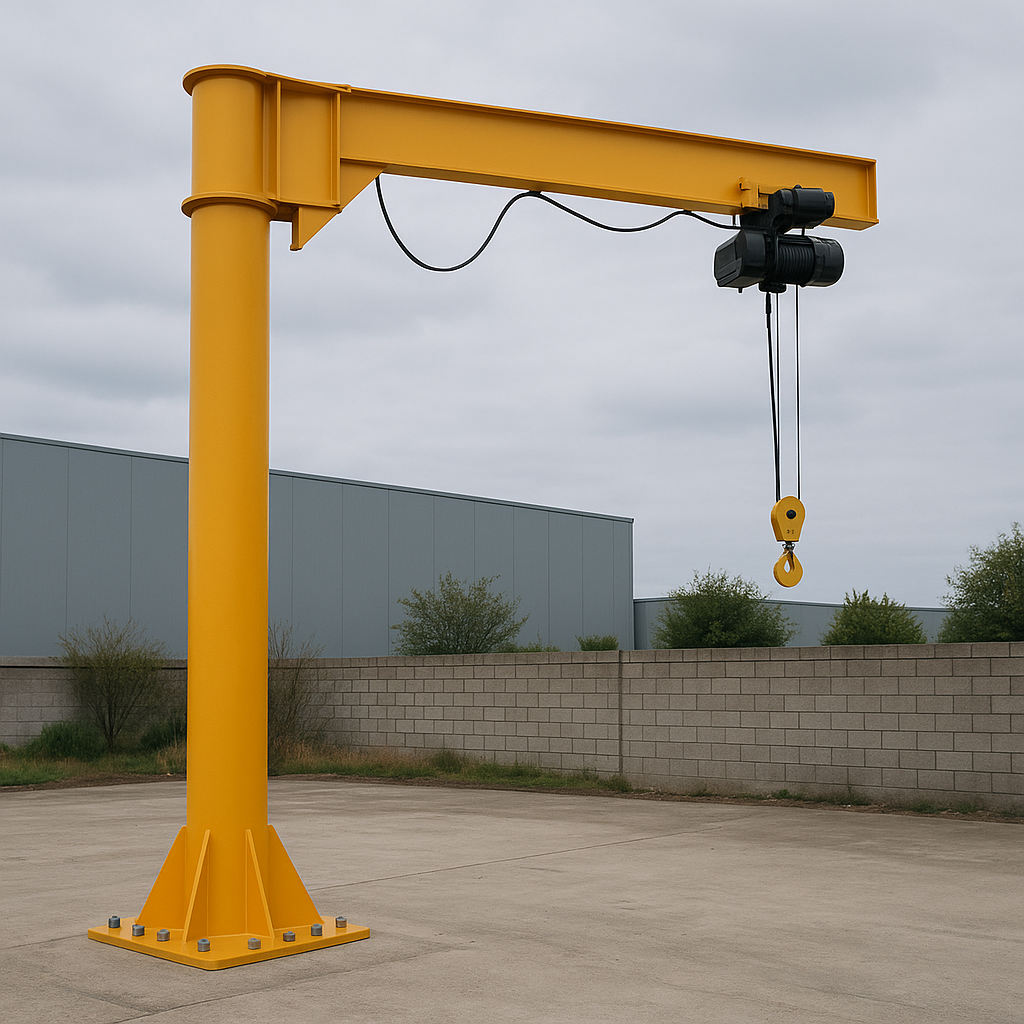In outdoor industrial environments—such as construction sites, shipyards, and storage yards—material handling demands equipment that is rugged, weather-resistant, and versatile. Among the most reliable solutions is the jib crane, a lifting system known for its simplicity, efficiency, and adaptability. However, not all cranes are suitable for outdoor use. Selecting the right type for your application is crucial to ensuring safety, productivity, and long-term performance.
This guide explores the best types for outdoor material handling, highlighting key differences and optimal use cases.
What Is a Jib Crane?
Table of Contents
ToggleA jib crane is a type of lifting equipment that features a horizontal arm (called a jib or boom) attached to a vertical mast or wall mount. The arm supports a hoist, which moves loads in a defined arc. Jib cranes are commonly used for repetitive lifting and precise material positioning, making them essential for outdoor and indoor handling alike.
For foundational insight on applications across industries, see:
📎 Jib Crane: Choosing the Right Type by Application and Industry
Why Use a Jib Crane Outdoors?
Outdoor material handling presents unique challenges:
- Uneven terrain
- Exposure to weather conditions (rain, sun, wind)
- Lack of overhead support structures
- Need for mobile or flexible equipment setups
A well-chosen crane addresses these issues by offering durable construction, wide rotation coverage, and independence from building infrastructure.
Top Jib Crane Types for Outdoor Use
Not all cranes are built for outdoor environments. Below are the best options and why they work in such settings.
1. Freestanding
The freestanding crane is the most versatile option for outdoor applications. It’s anchored directly to a concrete foundation and does not rely on any building support, offering up to 360° rotation.
Key Benefits:
- Fully self-supporting
- Ideal for open yards and large outdoor workspaces
- Handles medium to heavy loads (up to 5 tons or more)
- Customizable height and boom length
Ideal Applications:
- Construction sites
- Loading docks
- Shipbuilding
- Precast concrete handling
📎 Compare options: Jib Crane: Key Differences between Freestanding vs Wall-Mounted
2. Mast-Type (Mast-Mounted)
A mast-type crane uses both floor and ceiling (or top beam) support. It doesn’t require a special concrete foundation, making it an efficient alternative when partial structural support is available—even outdoors under covered open structures.
Key Benefits:
- 360° rotation like freestanding cranes
- Lower cost than full freestanding models
- Suitable for semi-permanent setups
Ideal Applications:
- Open-sided warehouses
- Covered outdoor yards
- Steel service centers
📎 Learn more: Jib Crane with Mast Design for Efficient, Space-Saving Lifting
3. Wall-Mounted Jib Crane (Limited Outdoor Use)
While wall-mounted cranes are typically used indoors, they can be adapted for outdoor use when attached to structural walls or support beams in open-air facilities. They’re limited in coverage (typically 180–200° rotation) and capacity but offer an affordable solution for smaller tasks.
Use With Caution Outdoors:
- Only when structural walls exist
- Should be weather-protected
- For light-duty use in outdoor corridors or lean-tos
📎 Compare: Jib Crane: Choose the Best Type for Your Workshop
Jib Cranes to Avoid Outdoors
Articulating Jib Crane
While highly flexible and precise, articulating cranes are typically designed for indoor environments. Their multiple pivot points are vulnerable to environmental elements, reducing reliability outdoors unless specially sealed and protected.
Choosing the Right Outdoor Jib Crane: Evaluation Checklist
When selecting a crane for outdoor use, consider the following factors:
| Criteria | Why It Matters |
|---|---|
| Weather Resistance | Materials like galvanized steel resist rust and corrosion |
| Foundation Support | Outdoor units must be securely anchored for wind stability |
| Load Capacity | Heavier loads require stronger structures and deeper foundations |
| Rotation Range | 360° rotation is ideal for full-yard coverage |
| Maintenance Access | Outdoor cranes need accessible inspection points |
| Space and Obstructions | Must account for site layout, vehicles, and storage racks |
Enhancing Outdoor Jib Cranes with Electric Hoists
Adding an electric hoist to your jib crane is essential for outdoor efficiency. These hoists provide consistent lifting speed, precision, and ease of use, especially when dealing with large or irregularly shaped materials.
Advantages:
- Less strain on workers
- Faster lifting cycles
- Controlled operation in variable weather
📎 Read more: Jib Crane Performance Enhanced by Electric Hoists
Outdoor Use Case Scenarios
1. Precast Concrete Manufacturing
- Recommended Crane: Freestanding
- Use: Lift concrete slabs from mold to yard
2. Shipping Yards
- Recommended Crane: Mast-type or freestanding
- Use: Load/unload shipping containers or steel pallets
3. Construction Material Storage
- Recommended Crane: Freestanding
- Use: Move rebar bundles, bricks, or tools from trailers to storage racks
Maintenance Tips for Outdoor Jib Cranes
- Inspect regularly for rust, bolt integrity, and wear on hoists
- Lubricate bearings and pivot points to prevent moisture-related corrosion
- Use weatherproof covers for unused cranes
- Apply anti-corrosion coatings during installation and touch-ups
Expert Insight: Why Aardwolf Jib Cranes Stand Out Outdoors
Aardwolf’s product line of freestanding and mast-type jib cranes are built with:
- Weather-resistant coatings
- Heavy-duty construction
- Customizable dimensions for specific site needs
- Engineering support for foundation planning
📎 Discover the full product range: for more jib crane products
Final Thoughts: Elevate Your Outdoor Operations
In outdoor material handling, investing in the right jib crane saves time, reduces accidents, and maximizes resource efficiency. The freestanding remains the gold standard for outdoor use, offering flexibility, durability, and wide-area coverage. For semi-structured environments, the mast-type is a cost-effective alternative.
📎 Continue exploring:


















Please log in to leave a comment.